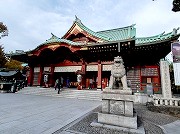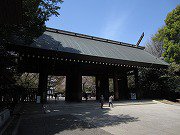Edo Castle - Guide
 Imperial Palace [江戸城跡] link
Imperial Palace [江戸城跡] link
Chiyoda-ku, Tokyo Pref.MAP
[East Garden] 9:00-17:00 Apr 15-Aug, 9:00-16:30, Mar-Apr 14 & Sep-Oct, 9:00-16:00 Nov-Feb; free; closed Mon*, Fri (open if holiday), Dec 23, Dec 28-Jan 3
The very core part of former Edo castle, which was the residence and government of Tokugawa shoguns, now remains as the Imperial Palace and Kitanomaru Park, though most of feudal-era buildings are gone. If you want to look around some other part of the Imperial Palace than the East Garden, you must make a registration (follow the link above). Also on Dec 23 and Jan 2 you can go in front of the palace building to greet the Imperial family, but you need to line up for a while and get a security check (the morning of Jan 2 is particularly crowded).
[details...]











 Kanda Jinja Shrine [神田明神(神田神社)]
Kanda Jinja Shrine [神田明神(神田神社)]
Chiyoda-ku, Tokyo Pref.MAP
In the Edo era Kanda Myojin was the Shinto shrine which assumed the role of the overall spiritual guardian of the town of Edo. Though nowadays Tokyo is full of concrete Shinto shrines to resist fire, before WWII it was rare because Shinto is a conservative religion and hesitated at first to accept this new material for its buildings. Thus, this shrine's present main buildings, completed in 1934, are one of the earliest examples of concrete shrine architecture. It is also known for the Kanda Matsuri held in mid-May.
[details...]5-min walk from JR Chuo Line Ochanomizu Station




 JR Tokyo Station Marunouchi Bldg [JR東京駅 丸の内駅舎]
JR Tokyo Station Marunouchi Bldg [JR東京駅 丸の内駅舎]
Chiyoda-ku, Tokyo Pref.MAP
The Marunouchi Bldg of JR Tokyo Station is a massive brick railway station built in 1914. The central entrance used to be solely for the imperial family.
[details...]



 Yushima Seido Temple [湯島聖堂]
Yushima Seido Temple [湯島聖堂]
Bunkyo-ku, Tokyo Pref.MAP
9:30-17:00 (-16:00 in winter); closed Aug 13-17 & Dec 29-31
This temple of Confucius was erected here initially in 1690, and its present Chinese-style buildings were built from 1934 to 1935 with concrete. Confucian temples are rare in Japan and among them this one is the most well-known.
[details...]2-min walk from JR Chuo Line Ochanomizu Station








 Hibiya Koen Park [日比谷公園]
Hibiya Koen Park [日比谷公園]
Chiyoda-ku, Tokyo Pref.MAP
Hibiya Park was opened to the public in 1903. It is one of the earliest parks to have a Western-style garden. There's a small Japanese garden as well. Many events are held here throughout the year, and a bon-odori dance festival in August is one of them.
[details...]Adjoining the Imperial Palace




 Akasaka Hie Jinja Shrine [赤坂日枝神社]
Akasaka Hie Jinja Shrine [赤坂日枝神社]
Chiyoda-ku, Tokyo Pref.MAP
Hie Jinja is a Shinto shrine which enshrines the spiritual guardian of Edo Castle. Its Sanno Matsuri, held in June, is one of the most well-known festival in Tokyo.
[details...]



 Yasukuni Jinja Shrine [靖国神社] link
Yasukuni Jinja Shrine [靖国神社] link
Chiyoda-ku, Tokyo Pref.MAP
6:00-17:00 Nov-Feb, 6:00-18:00 Mar-Apr & Sep-Oct, 6:00-19:00 May-Aug
Some facilities under restoration until summer of 2019.
Yasukuni Jinja is a Shinto shrine which honors some 2.5 million war-dead, most of them soldiers, since the Meiji Restoration of the late 19 century. It is the second largest Shinto shrine in Tokyo, the first being Meiji Jingu Shrine, and still preserves a complex built before WWII which was miraculously able to avoid being air raided. The admission fee for its war museum is 800 yen. It also holds notable events like the Shunki Reitaisai in April, the Sakura Matsuri in late March to early April, the Hono Ozumo in mid-April, the Mitama Matsuri in July, the Kusaji-shiki and the Shuuki Reitaisai in October, and the Shichigosan-no-gi in November. Many events are also held at the Hatsumode period in early January.
[details...]3-min walk from Kudanshita Station of the subway lines












Others
 National Diet Building 国会議事堂
National Diet Building 国会議事堂
Chiyoda-ku, Tokyo Pref.MAP
The National Diet Building was constructed in 1636. Diet is the English term for the Japanese parliament.

Map
Click a pin on the map or a button below the map to pop open a name balloon. Another click and it will close.
Shiba & Tsukiji - Guide
 Hama-rikyu Teien Garden [浜離宮恩賜庭園]
Hama-rikyu Teien Garden [浜離宮恩賜庭園]
Chuo-ku, Tokyo Pref.MAP
9:00-17:00; 300yen; closed Dec 29-Jan 1
Hama-rikyu is a Japanese stroll garden which draws in water from the sea to enjoy the changes of scenery caused by the tide. This garden was also able to be used as a fortress in case of emergency and used to be connected with the Edo Castle through canals and moats.
[details...]7-min walk from Toei Oedo Line Shiodome Station.












 Kyu-Shiba-rikyu Teien Garden [旧芝離宮恩賜庭園]
Kyu-Shiba-rikyu Teien Garden [旧芝離宮恩賜庭園]
Minato-ku, Tokyo Pref.MAP
9:00-17:00 150yen closed Dec 29-Jan 3
Kyu-Shiba-rikyu is a Japanese stroll garden founded by an Edo-era domain lord. Like Hama-rikyu it was initially built on the seashore and used to draw in sea water likewise but not anymore.
[details...]Next to JR Yamanote Line Hamamatsucho Station








 Zojoji Temple [増上寺] link
Zojoji Temple [増上寺] link
Minato-ku, Tokyo Pref.MAP
[Treasure Exhibition Room & Mausoleums of Tokugawa Shoguns] 10:00-16:00; 1000 yen; closed Tue*, Dec 28-31
Zojoji is a major Jodo Buddhist temple. It was one of the three temples where the tombs of Tokugawa shoguns were placed. Though most of the temple buildings, including shoguns' gorgeous tombs, were burned down in WWII, the main gate and several other peripheral buildings still remain. On April, there will be held a festival called the Gyoki-daie honoring sect founder Honen, and a mikoshi procession called Jizoson Daihoyo.
[details...]5-min walk from Toei Mita Line Onarimon Station












 Atago Jinja Shrine [愛宕神社]
Atago Jinja Shrine [愛宕神社]
Minato-ku, Tokyo Pref.MAP
Atago Jinja is a Shinto shrine located on top of 26-meter-high (85-foot-high) Atago Hill.
[details...]8-min walk from Toei Mita Line Onarimon Station




 Seishoji Temple [青松寺]
Seishoji Temple [青松寺]
Minato-ku, Tokyo Pref.MAP
Seishoji is a Soto Zen temple with traditional but at the same time modern appearance.
[details...]7-min walk from Toei Mita Line Onarimon Station




Others
 Tsukiji Honganji Temple 築地本願寺[HP]
Tsukiji Honganji Temple 築地本願寺[HP]
Chuo-ku, Tokyo Pref.MAP
Tsukiji Honganji is a Shin Buddhist temple. The massive temple building constructed in 1934 is probably the first Indian-style architecture in Japan.
[details...]1-min walk from Tokyo Metro Hibiya Line Tsukiji Station

 Tsukiji Jogai Market 築地場外市場
Tsukiji Jogai Market 築地場外市場
Chuo-ku, Tokyo Pref.MAP
Tsukiji Jogai Market is a market district full of nostalgic atmosphere.
[details...]
 Tsukiji Namiyoke Inari Jinja Shrine 波除稲荷神社
Tsukiji Namiyoke Inari Jinja Shrine 波除稲荷神社
Chuo-ku, Tokyo Pref.MAP
Namiyoke Jinja is a small Shinto shrine located next to Tsukiji Fish Market.
[details...]5-min walk from Toei Oedo Line Tsukiji-shijo Station

 Tsukuda Sumiyoshi Jinja Shrine 佃住吉神社
Tsukuda Sumiyoshi Jinja Shrine 佃住吉神社
Chuo-ku, Tokyo Pref.MAP
Sumiyoshi Jinja is a Shinto shrine located in a district with somewhat nostalgic atmosphere.
[details...]6-min walk from Tsukishima Station of the Toei Oedo Line or the Tokyo Metro Yurakucho Line

Map
Click a pin on the map or a button below the map to pop open a name balloon. Another click and it will close.




 Kabukiza Theater
Kabukiza Theater 